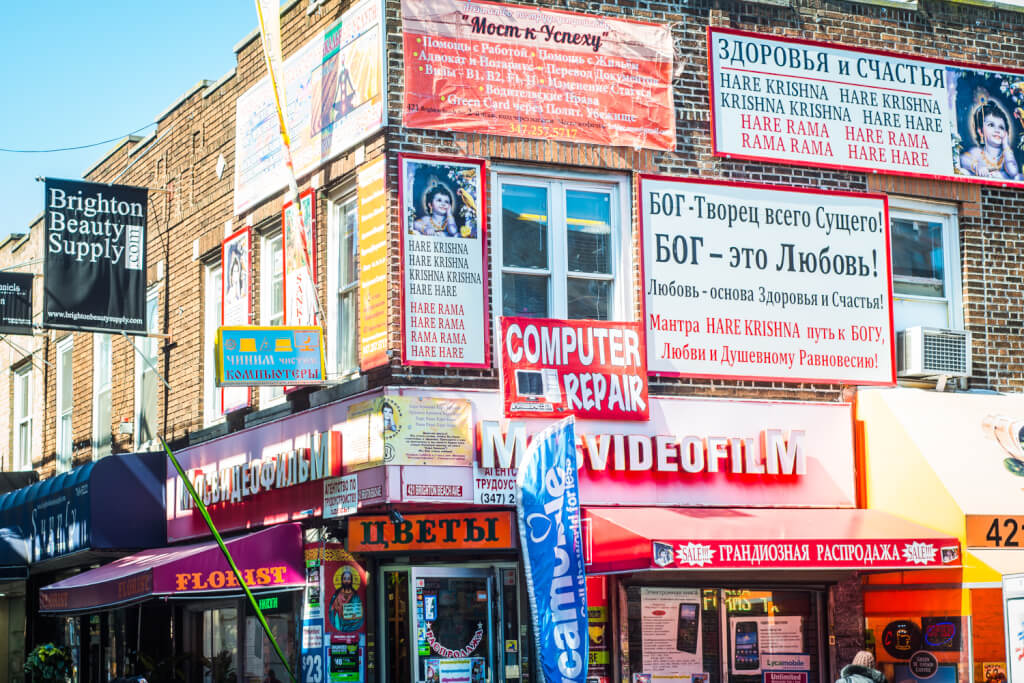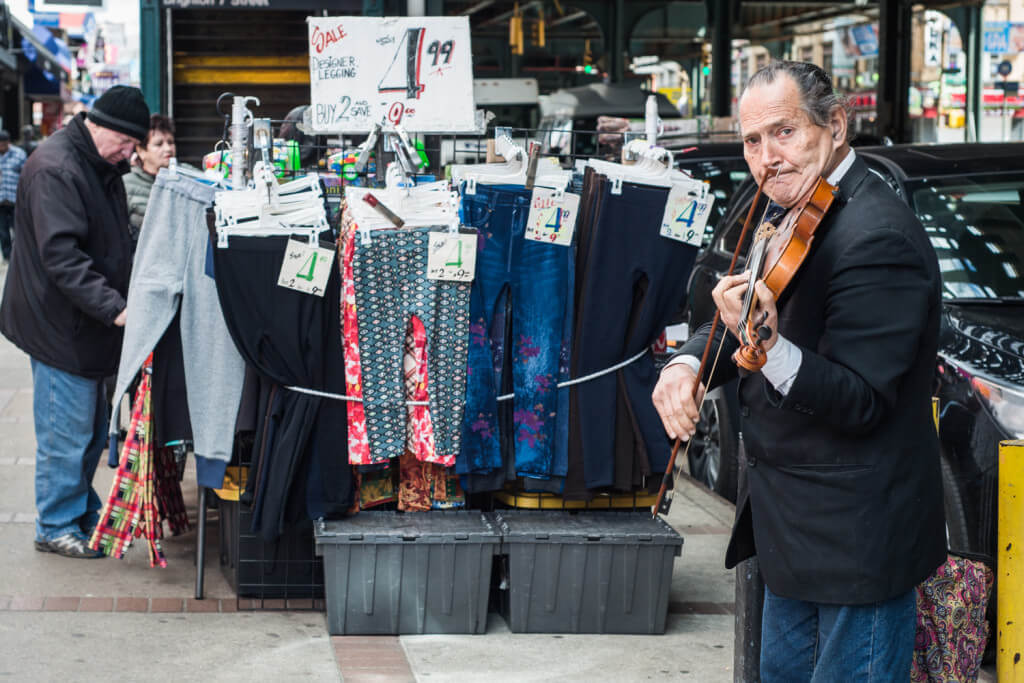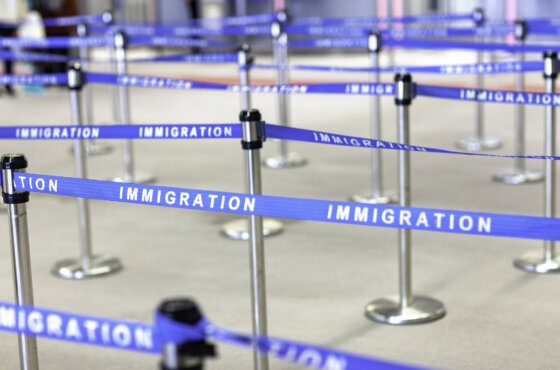Four waves of Russian immigration: who are these people

At Brighton Beach you can get any information in Russian. Photo: Pavel Terekhov
It is believed that 4 was a pronounced wave of Russian immigration to the United States. Let's figure out when it was, and who exactly traveled. For information we will attract Wikipedia and some other free sources.
As the US census 2000 of the year showed, about 735 thousands of Americans indicated Russian as their mother tongue, which is three times higher than the figures that the US census 1990 of the year showed - 242 thousands of people. Russian language has taken 7 a place by prevalence in the USA. However, according to experts, only about a quarter of the Russian-speaking United States is actually Russian.
More than half of the native speakers are Jews, as well as citizens of the other former Soviet republics, who, due to various circumstances, know Russian better than ethnic. The number of Russian speakers in the United States grew unevenly; it increased especially rapidly after the collapse of the USSR in 1990.
Estimated, including illegal immigrants, today in the US are about 2.7 million Russian-speaking. Some of the Russian immigrants (especially those who came from the Russian Empire, as well as their descendants) practically do not speak Russian, having lived in the United States for a total of over 100 years.
Waves of immigration from Russia to the United States always had a peculiar character, distinct, say, from the British (mass migration) or Mexican (labor). In almost all periods, the main group of arrivals was made up of Jews who sought life more free from religious, political, and other restrictions in the Russian Empire and USSR.
There are 4 conditional waves of Russian immigration to the United States.
First was associated with the Russian exploration of America in the eighteenth and nineteenth centuries, and was represented by few Russian researchers who founded settlements along the coast of the Pacific Ocean.
The second It took place at the turn of the 19-20 centuries and was represented by Jews from the Russian Empire.
The third - a small wave - was represented by political emigrants (mostly also Jews) from the USSR at the end of 60's, beginning of 70's.
And, finally, the most massive influx (fourth wave) came at the time of the fall of the Iron Curtain at the end of 1980-x - the beginning of 1990-s, when numerous groups of Jews, Russians, Ukrainians and others arrived (mostly already at the turn of the 20-21 century).
Emigration is younger

In the area of Brighton Beach today live from 50 to 70 thousands of Russian-speaking people. Photo: Pavel Terekhov
Additional, extended information on the waves of emigration of Russians in the USA I got it в Bureau of International Information Programs, US Department of State.
Following the gradual easing of restrictions on leaving the Soviet Union, an unprecedented influx of immigrants from the region was observed in the United States at the end of the 1980s. According to the US immigration statistics published by the Bureau, in the period from 1990 to 1999, over 433 thousands of people who came from Russia and other former Soviet republics were eligible for permanent residence in the United States, compared to 65 thousands for the entire period after World War II.
“I am amazed at the peculiarities of the composition of this group,” says Vera Kishinevskaya, author of the book “Russian Immigrants in the United States: Adaptation to American Culture”. - Previously, these were mainly Russian Jews and specialists. Now come the Kazakhs, Tatars, Ukrainians - essentially all ethnic groups. ”
Marina Shron, a bilingual author from New York who writes in Russian and in English, notes that most people from this group come to the United States not because of political pressure, but in search of better opportunities and new sensations. “For the most part, these are people who leave not by necessity, but of their own accord,” said Schron, who wrote Denis Sasha’s book The Red Blues: Voices from the Last Wave of Russian Immigrants.
The first waves of immigration
Immigrants from the Russian Empire (and later the Soviet Union) came to the United States in several large waves. In the second half of the 19th century, dispossessed residents of the empire's western outskirts—mostly Poles, Belarusians, and Lithuanians—came to America in search of a better life. This immigrant group included many Jews and members of oppressed religious minorities, as well as a number of political exiles.
Another major wave of immigration followed the chaos of the October Revolution. The number of so-called “white Russians” included many representatives of the Russian intellectual and creative elite: engineers and inventors like Vladimir Zworykin, Igor Sikorsky or Alexander Ponyatov, composers Alexander Prokofyev, Sergey Rakhmaninov and Igor Stravinsky, writers Vladimir Nabokov and Alisa Zinovyevna Rozenbaum, who received fame in America under the name of Ayn Rand.
After World War II, emigration from the Soviet Union almost ceased. It resumed in the era of detente in the 1970s. Without risking international ostracism for imprisonment of an increasing number of prominent dissidents, the Soviet regime allowed some of them to emigrate. Sometimes, as in the case of writers Alexander Solzhenitsyn and Joseph Brodsky, they were actually forced to leave.
According to the 1975 Helsinki Accords, more and more Soviet Jews were able to leave the country. In some cases, the tour of Soviet artists abroad ended with sensational shoots, one of which was performed by dancer Mikhail Baryshnikov, who later became the artistic director of the American Ballet Theater in New York.
In the US census in 2000, almost 2 a million Americans declared their Russian roots, and about the same number called the Soviet Union the place of origin. After the Poles (over 6 millions), Russians and Russian speakers today are the most numerous group who speak one of the Slavic languages in the United States.

Photo dezinfo.net
New wave of immigrants from Russia and the former Soviet Union
Judging by a number of recent press reports, the new wave of immigrants from Russia and the former Soviet Union is very enterprising and able to adapt to American life. But it also creates a dynamic Russian-American environment that combines the lifestyle and aspirations of both cultures.
The writer Vera Kishinevskaya indicates that the number of Russian-language events in the world of art, publications, services, and even preschool institutions that appear in major American cities, shows that this group no longer seeks for complete cultural assimilation. Its members tend to give their children a bilingual and intercultural education and want them to retain a sense of their special affiliation as part of American society.
“We brought quite a few books from Odessa,” says 30-year-old Pavel, who came to the United States with his parents, grandparents in 1988. Today, Pavel speaks good Russian and keeps in touch with friends of his parents from Odessa, many of whom also live near Washington.
On the other hand, he recalls that his family never feared America. They treated the new place with hope and curiosity. “America is good. But it is different, so we need to know how it differs. We really wanted to succeed in America, ”he says.
Alexandra, who has been living in the United States since 1993, is trying to protect her 9-year-old son, who was born in America, from the unhealthy, in her opinion, influence of American mass culture, “especially television”. In this, according to her, her husband is fully supported by an American. She gave the boy to an international school and brings him up simultaneously in three languages - English, Russian and German.
“I want him to grow up as a man without prejudice and prejudice, everywhere he felt at home, was a citizen of the world,” she said.
Marina Shron notes that children of newly arrived immigrants usually consider themselves Russian-Americans or Russians. “They are interested in everything Russian - Russian names, American writers of Russian origin,” she says, indicating that this was not always the case in previous generations.
Emigration is no longer a scary thing
According to new immigrants from Russia and Eastern Europe, immigration is still associated with its inherent stress - attempts to get used to the new language, establish its professional authority, and adapt to new social relations and norms. But those who have come recently also say that the world has become more similar, and the cultural shock caused by the arrival in America today is much weaker than the one that was experienced by previous generations.
The most important thing, they said, is that the new emigration, unlike the first waves, has lost the weight of the irreversible, often tragic decision that it was under communism. Those who left the Soviet Union usually proceeded from the fact that they would never see their homeland again.
Vera Kishinevskaya, who came to the US 30 years ago, said that in her times “Russians left Russia the way people die”, breaking all emotional ties with the country and the people they left. Today, she said, they can travel to the country from which they emigrated and visit relatives. They are still interested in events in Moscow or the news of Tatarstan. They have access to Russian television, Russian radio and newspapers in Russian, published in the United States and in Russia.
Printed with permission. Author.
See also:
How many Russians returned home from emigration
10 things that change in emigration without being noticed
How an illegal immigrant can be legalized in the USA
Subscribe to ForumDaily on Google NewsDo you want more important and interesting news about life in the USA and immigration to America? — support us donate! Also subscribe to our page Facebook. Select the “Priority in display” option and read us first. Also, don't forget to subscribe to our РєР ° РЅР ° Р »РІ Telegram and Instagram- there is a lot of interesting things there. And join thousands of readers ForumDaily New York — there you will find a lot of interesting and positive information about life in the metropolis.











